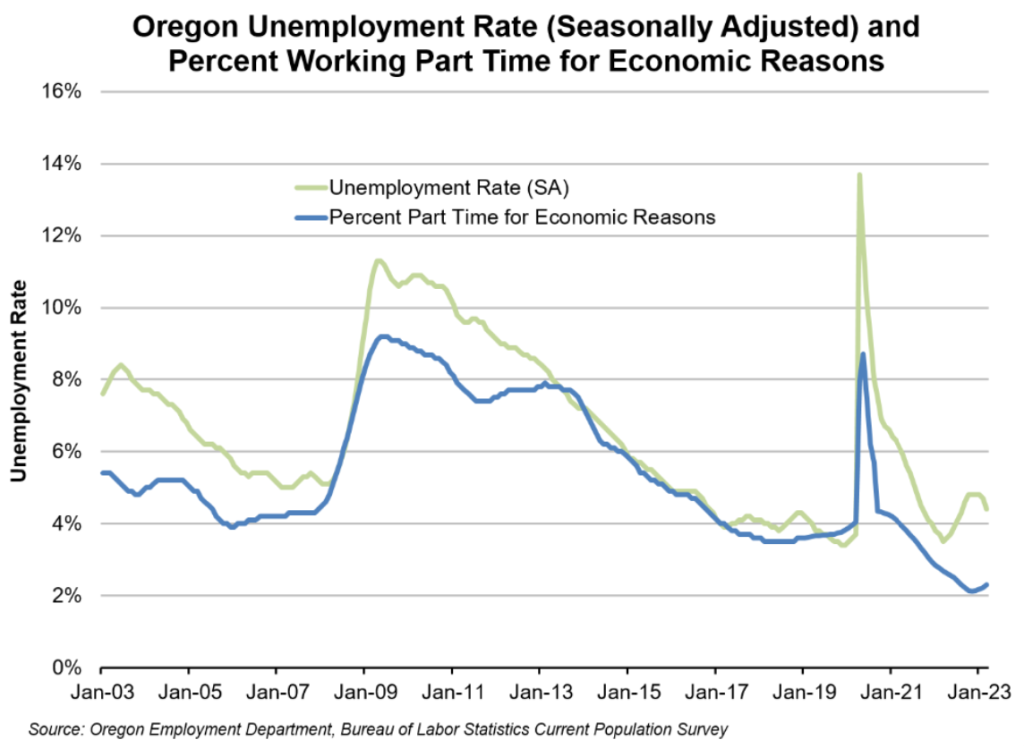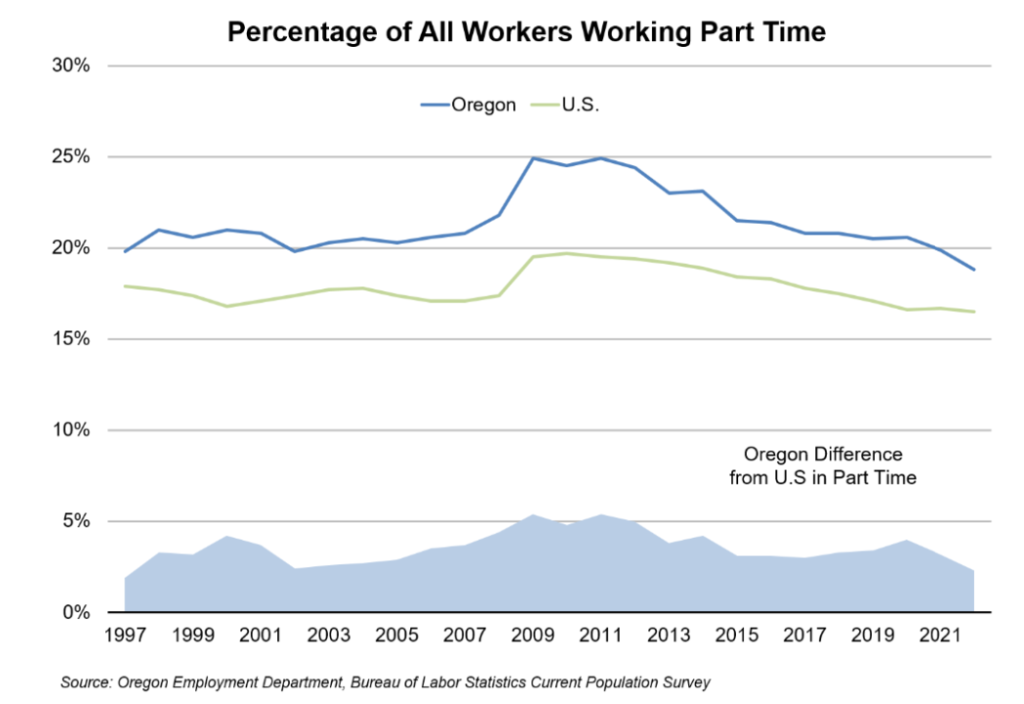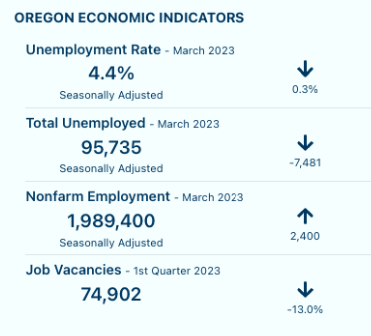Oregon’s Part-Time Workers: One-Fifth of Employment in 2022

Although most people work in full-time jobs, around 19% of employed Oregonians usually worked part-time schedules in 2022. People work part time for a variety of reasons. Part-time jobs offer flexibility for some who seek a job that fits their circumstances, such as students, those looking for additional income from seasonal work, or a spouse in a household with young children. Workers in those circumstances are generally considered the “voluntary part-time employed.”
Another group of part-time workers is the “involuntary part-time employed.” These are people working part-time schedules because they can’t find full-time employment or have had their hours cut at work from a usual full-time schedule down to a part-time schedule because of economic conditions, such as slack work, unfavorable business conditions, or a slow economy.
The Current Population Survey (CPS) collects data for the U.S. and Oregon about full- and part-time workers. Those figures include the demographics of people working part time, reasons for working part time, and how these numbers change over time. Among several things, these data can be used to determine how many people are “voluntarily” or “involuntarily” working part time.
What Is a Part-Time Worker?

Although full- and part-time job classification can be generally thought of as working above or below a fixed number of hours per week, the reality is more complex since people generally have a “usual” number of hours that they work per week, an “actual” number of hours they did work each week, and a “preferred” number of hours they would like to work each week. The Bureau of Labor Statistics (BLS) distinguishes between usual full- and part-time workers based on 35 hours per week:
Full-time worker: a person who usually works 35 or more hours during the survey reference week (at all jobs combined).
Part-time worker: a person who usually works fewer than 35 hours per week (at all jobs combined).
Usual work schedules, actual work schedules, and preferred work schedules may differ. The actual hours a person is at work during a week may differ from the usual number of hours they work for “noneconomic” or “economic” reasons. Noneconomic reasons could be family or personal obligations, school or training, vacation, illness, or bad weather. Economic reasons include slack work, material shortages, and repairs to plant or equipment. For example, if a person who usually works 40 hours per week goes on vacation for a couple of days, their usual work status would classify them as a “usual full-time worker” but the actual number of hours worked would be less than 35. Thus, this person would be a usual full-time worker who was at work between 1 and 34 hours for noneconomic reasons.
The close relationship between employment and overall economic conditions was clear during the last two recessions, when unemployment rates increased and the percentage of those working part time for economic reasons increased. As hours were cut back and employees laid off, more people turned to part-time employment.
Characteristics of Part-Time Workers
Of the 158.3 million people employed in the U.S. in 2022, 132.2 million (83.5%) were employed full time and 26 million (16.5%) were employed part time. Percentages in Oregon were different, with 81.2% of Oregon’s total employment usually working full time and 18.8% usually working part time in 2022. Taking a longer-term perspective, Oregon tends to have a higher percentage of part-time workers than the U.S.
U.S. data show that both younger and older workers are more likely to work part time. In 2022, 41.5% of workers aged 16 to 24 years and 20.0% of workers aged 55 years and over worked part time. In contrast, only 10.4% of workers aged 25 to 54 years, a group traditionally considered to be of “prime working age,” worked part time. Younger workers are likely working part-time schedules for reasons related to school attendance, and older workers are likely working part time for reasons surrounding the transition to retirement from a “full-time career job.”
Oregon data by specific age group from the CPS are limited to age 16 to 19 years. However, Oregon data for 2022 tell a similar story with workers aged 16 to 19 years more likely to be working part time. Approximately 68% of employment for those aged 16 to 19 years was part time.
Although both men and women are more likely to be employed full time rather than part time, a majority of those working part time are women. In 2022, nearly two-thirds (62.7%) of U.S. part-time workers were women, and slightly less than one-third (37.3%) were men. Less than half of part-time workers are married with a spouse present (43.3%). About 43% of part-time workers have never been married, and around 14% are widowed, divorced, or separated. Oregon data by gender for 2020 show around 63% of part-time workers are women.

Trends in Part-Time Employment
In 2022, the highest concentration of part-time employment in the U.S. was in service occupations, with 37% of total employment in these occupations being part time. Included in this group are occupations such as fast food and counter workers, and waiters and waitresses. Other occupations with high concentrations of part-time workers are sales and office occupations (26% of employment in this occupation) which include jobs such as retail sales workers. About 16% of natural resources, construction occupations are part-time, the lowest rate of the major occupation groups.
The industries with the highest percentage of part time workers are leisure and hospitality (42%), wholesale and retail trade (28%) and education and health services (24%). The industries with the lowest share of workers in part time roles were manufacturing (11%), construction (14%) and financial activities (14%).
Part-time employment offers a wide range of opportunities; the reasons vary by individual circumstances as well as economic conditions. Approximately 17% of workers in the nation worked part time in 2022, compared with 19% of Oregonians. Nationally and statewide, younger and older workers are more likely to work part time, as are women. The percentage of those working part-time for economic reasons rose and fell in tandem with the changes in the unemployment rate over the last 20 years. Whether part-time employment is voluntary or involuntary, the range of occupations provides opportunities for many Oregonians.
By Henry Fields
Workforce Analyst
Douglas and Lane counties
Oregon Employment Department
https://www.qualityinfo.org/-/oregon-s-part-time-workers-one-fifth-of-employment-in-2022


Advertisement